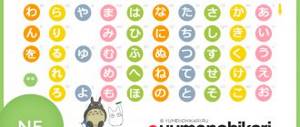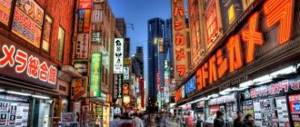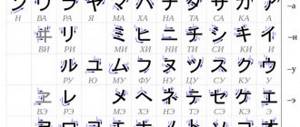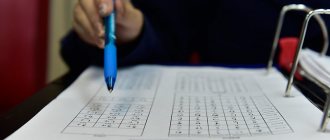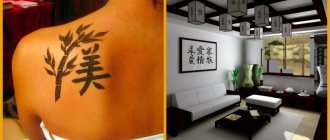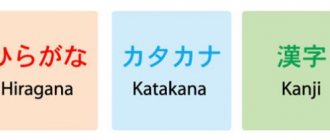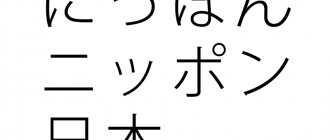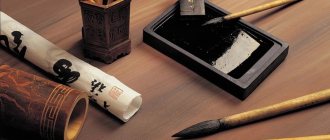Stroke order
From the very beginning of studying, pay attention to the correct order and direction of the lines to avoid bad habits. Often students don't see the point in stroke order if the result is the same. But what they miss is that there are thousands of characters and they are not always written as carefully as they appear on print. The correct stroke order helps you recognize hieroglyphs, even if you write quickly or by hand.
The simplest symbols, called radicals, are often used as components of complex symbols. Once you learn the stroke order of the radicals and get used to the principle, you will find that it is not difficult to guess the correct order for most kanji.
Most often, strokes are applied from the upper left corner to the lower right. This means that horizontal strokes are usually drawn from left to right, and vertical strokes are usually drawn from top to bottom. In any case, when you are in doubt about the stroke order, consult a Kanji dictionary.
Katakana
Katakana, which means "fragmentary kana", is used mainly to write foreign words and names, loanwords and words of onomatopoeia. Some of the most useful Japanese words are untranslatable onomatopoeias , such as ギリギリ (girigiri), which means “extremely, extremely,” which is used when, for example, running through the closing doors of a train at the last minute or being on time for class to start in a second.
Like hiragana, katakana has 5 vowels, 40 syllables and 1 consonant. Often you'll see both hiragana and katakana in a 5x10 chart called gojuon (五十音) or "fifty sounds."
The use of katakana is sometimes similar to the cursive in English used to transcribe foreign words in Japanese. Gairaigo (来語), or loanwords, are all written in katakana, such as バナナ for banana. Foreign names are also written in katakana.
Kanji in the lexicon
Modern Japanese uses a little over 2 thousand characters, and memorizing each one individually does not work as well as with hiragana.
An effective strategy for mastering kanji is to study with new words with more context. So, to consolidate in memory, we associate a symbol with contextual information. Kanji is used to represent real words, so focus on the words and vocabulary rather than the characters themselves.
You'll see how kanji works by learning a few common kanji and words in this paragraph.
Kanji readings
The first kanji we'll learn is 「人」, the character for "person". This is a simple symbol of two lines, each of which is drawn from top to bottom. You may have noticed that the character in the font doesn't always look like the handwritten version below. This is another important reason to check the order of strokes.
| Meaning: person; personality | |
| Kun'yomi: ひと | |
| Onyomi: ジン |
Kanji in Japanese have one or more readings, which are divided into two categories: kun'yomi (or kun, or kun reading) and on'yomi (or he, or on reading). Kun'yomi is the Japanese reading of the character, while on'yomi is based on the original Chinese pronunciation.
Kun'yomi is mainly used for words of one character. As an example, here is a word meaning “person”:
人【ひと】 - person
Kun'yomi is also used for native Japanese words, including most adjectives and verbs.
Onyomi is mostly used for words that come from Chinese, often consisting of two or more kanji. For this reason, onyomi is often written in katakana. More examples will follow as we learn kanji. One very useful example of onyomi is adding 「人」 to country names to describe nationality.
Examples:
- アメリカ人 【アメリカ・じん】 - American
- フランス人 【ふらんす・じん】 - French
Although most kanji do not have many kun'yomi or on'yomi, the most common kanji, like 「人」, have many readings. Here I will provide only readings that apply to the words being studied. Learning the readings without word context creates unnecessary confusion, so I don't recommend teaching all the readings at once.
Now that we've gotten to know the general idea, let's learn a little more words and their accompanying kanji. The red dots on the stroke order diagrams show where each stroke begins.
- 日本 【に・ほん】 – Japan
- 本【ほん】 - book
| 日 | Meaning: sun; day |
| Onyomi: ニ |
| 本 | Meaning: basis, source; book |
| Onyomi: ホン |
- 学生 【がく・せい】 - student
- 先生 【せん・せい】 - teacher
| 学 | Meaning: teaching; knowledge; the science |
| Onyomi: ガク |
| 先 | Meaning: ahead; precedence, superiority |
| Onyomi: セン |
| 生 | Meaning: life |
| Onyomi: セイ |
- 高い【たか・い】 - tall; Expensive
- 【がっ・こう】 – school
- 高校 【こう・こう】 - high school (third level of education, equivalent to grades 10–12 in our country)
| 高 | Meaning: high; Expensive |
| Kun'yomi: たか・い | |
| Onyomi: コウ |
| 校 | Meaning: school |
| Onyomi: コウ |
- 小さい【ちい・さい】 - small
- big
- Primary school (first stage of education, corresponds to grades 1–6 in our country)
- 中学校 【ちゅう・がっ・こう】 - secondary school (second stage of education, grades 7–9 here)
- 大学 【だい・がく】 - college; university
- 小学生 【しょう・がく・せい】 - elementary school student
- 中学生 【ちゅう・がく・せい】 - high school student
- 【だい・がく・せい】 – student
| 小 | Meaning: small |
| Kun'yomi: ちい・さい | |
| Onyomi: ショウ |
| 中 | Meaning: middle; inside |
| Onyomi: チュウ |
| 大 | Meaning: big |
| Kun'yomi: おお・きい | |
| Onyomi: ダイ |
- 国【くに】 - country
- 中国 【ちゅう・ごく】 – China
- Chinese
| 国 | Meaning: country |
| Kun'yomi: くに | |
| Onyomi: コク |
- 日本語【に・ほん・ご】 - Japanese
- Chinese language
- 英語【えい・ご】 - English
- フランス語【フランス・ご】 - French
- スペイン語 【スペイン・ご】 - Spanish
| 英 | Meaning: England |
| Onyomi: エイ |
| 語 | Meaning: language |
| Onyomi: ゴ |
With just 14 characters, we've learned over 25 words - from Chinese to schoolboy! Kanji is usually perceived as a major learning obstacle, but can easily be turned into a valuable tool when learned alongside words.
Hiragana
Hiragana, which literally means "ordinary" or "simple" kana, is used primarily for native Japanese words and grammatical elements. There are 46 basic characters that represent syllabic marks, or 71 characters if counted together with diacritics. Each sound in Japanese corresponds to one character in the syllabary. Typically, students learn hiragana first, followed by katakana and kanji.
Hiragana is also used for furigana (ふりがな) or yomigana (読み仮名), small characters that reflect the pronunciation of characters written above or next to them. It helps to read a character that you may not yet know, so initially you need to master kana as best as possible! Books intended for young children are often written only in hiragana.
Hiragana is also used to write okurigana (送り仮名) - endings after the main character, which can reflect the meaning of verbs and adjectives, grammatical constructions and Japanese native words that do not have characters or if the characters are too complex. These basic Japanese syllabic characters can also be modified by adding the sign dakuten (濁点) - (゛) or handakuten (半濁点) - (゜).
This can all be a little confusing, but don't worry—the longer you study Japanese, the easier it will be to remember the alphabet. However, to get started, it may be helpful to use an app like Hiragana Quest . It uses mnemonics that make symbols easier and easier to remember. Find out more about the app here!
Okurigana and changing readings
You may have noticed that some words end in hiragana, such as 「高い」 or 「大きい」. Since these are adjectives, the accompanying hiragana, called okurigana, is needed for various transformations without affecting the kanji. Remember exactly where kanji ends and hiragana begins. There is no need to write 「大きい」 as 「大い」.
You may also notice that the kanji readings individually do not match the readings in some words. For example, 「学校」 is read as 「がっこう」, not 「がくこう」. Readings are often transformed in this way to make pronunciation easier.
Ideally, check your reading of each word that is new to you. Luckily, with the help of online and electronic dictionaries, finding new kanji is easy. Kanji Search Guide
Memory technique
Understanding the keys already makes the task a lot easier, but to find an effective method for studying them we need to repeat a little of what we know about human memory. What do we do when we try to remember something? We believe that to memorize, you just need to periodically repeat the learned material. This is true, but when we need to learn and not confuse 2136 incomprehensible squiggles, this method quickly becomes another problem. Kanjiway uses several different memory techniques to help you retain information more easily. Let's return to the kanji 町. Instead of just trying to remember the equation “rice field + street = village,” we can use our visual memory and create a story that will help us reproduce the kanji elements in our head. Imagine that you are walking down a STREET and come across a large RICE FIELD where people from the nearest VILLAGE are working. Right now, try spending 5 seconds replaying this scene in your mind, rather than just reading a sentence in this article. The next time you come across the kanji 町 you will see two constituent elements and you will immediately remember this story, which will help you quickly get to the very meaning of the kanji. Here's another example: 則 (law, rule, rule) consists of 貝 (shell/clam) and 刂 (sword). We can imagine a MOLLUSK who came to the village with a huge SWORD, overthrew the government and began to establish his own RULES/LAWS.
When coming up with different stories and scenes for memorizing kanji, try to be based on the following principles:
- The story must be greatly exaggerated. Instead of imagining an ordinary clam, you can imagine a huge tyrant clam with a giant sword in his hand. The weirder and funnier the story, the better.
- The story should contain small details that will help you remember the story itself. You can imagine screaming defenseless children looking in fear at their new ruler - a tyrant clam.
- When you imagine a story in your head, try to additionally involve other senses, such as touch, smell, sound. To this image you can add the screams of women who are enslaved by a new tyrant mollusk, you can imagine how you yourself are in the village and smell the tyrant mollusk a few meters away, and so on.
You will probably say that this is very stupid, but the strength of this technique lies precisely in its apparent frivolity. It is much easier for people to remember things that evoke some kind of emotion in them, even the most minimal, and even if this emotion is “Oh my God, how stupid this is.” These are the methods that people who compete in memory championships use in their practice; with their help, a person can remember 100 random numbers in a row, the order of cards in a deck, or a speech that needs to be delivered on stage.
Information + emotion = memory
This technique allows us to memorize kanji much faster, but the kanji will still need to be repeated, otherwise you will forget them in a couple of weeks.
Different kanji for similar words
Kanji is often used to create nuance or give a different flavor to the meaning of a word. For some words, it is important to use the correct kanji in the right situation. For example, the adjective 「あつい」 - “hot” - when describing climate is written as 「暑い」, and when talking about a hot object or person - 「熱い」.
| 暑 | Meaning: hot (climate description only) |
| Kun'yomi: あつ・い |
| 熱 | Meaning: heat; fever |
| Kun'yomi: あつ・い |
In other cases, although kanji are used that are correct for all meanings of the chosen word, the author has the right to choose characters with a narrow meaning according to style. The examples in this book generally use common and simple kanji. For details on using different kanji for the same word, see the Word Study Guide.
Arguments against
There are actually three pretty good arguments against writing exclusively in hiragana.
- Since kanji were developed before hiragana, writing with kanji usually commands respect for an intelligent and mature author . Of course, you can write "kuruma " asくるまand be understood, but this will look childish ("collective farm") to Japanese readers , so educated adults should write車.
- However, if everyone in Japan did this, eventually the stigma of being a stupid hillbilly (or child) when using only hiragana would disappear. It's just as if humanity has collectively decided that, starting tomorrow, chocolate milk is a perfectly acceptable drink to serve at formal business meetings.
Proverbs and sayings of Japan.
